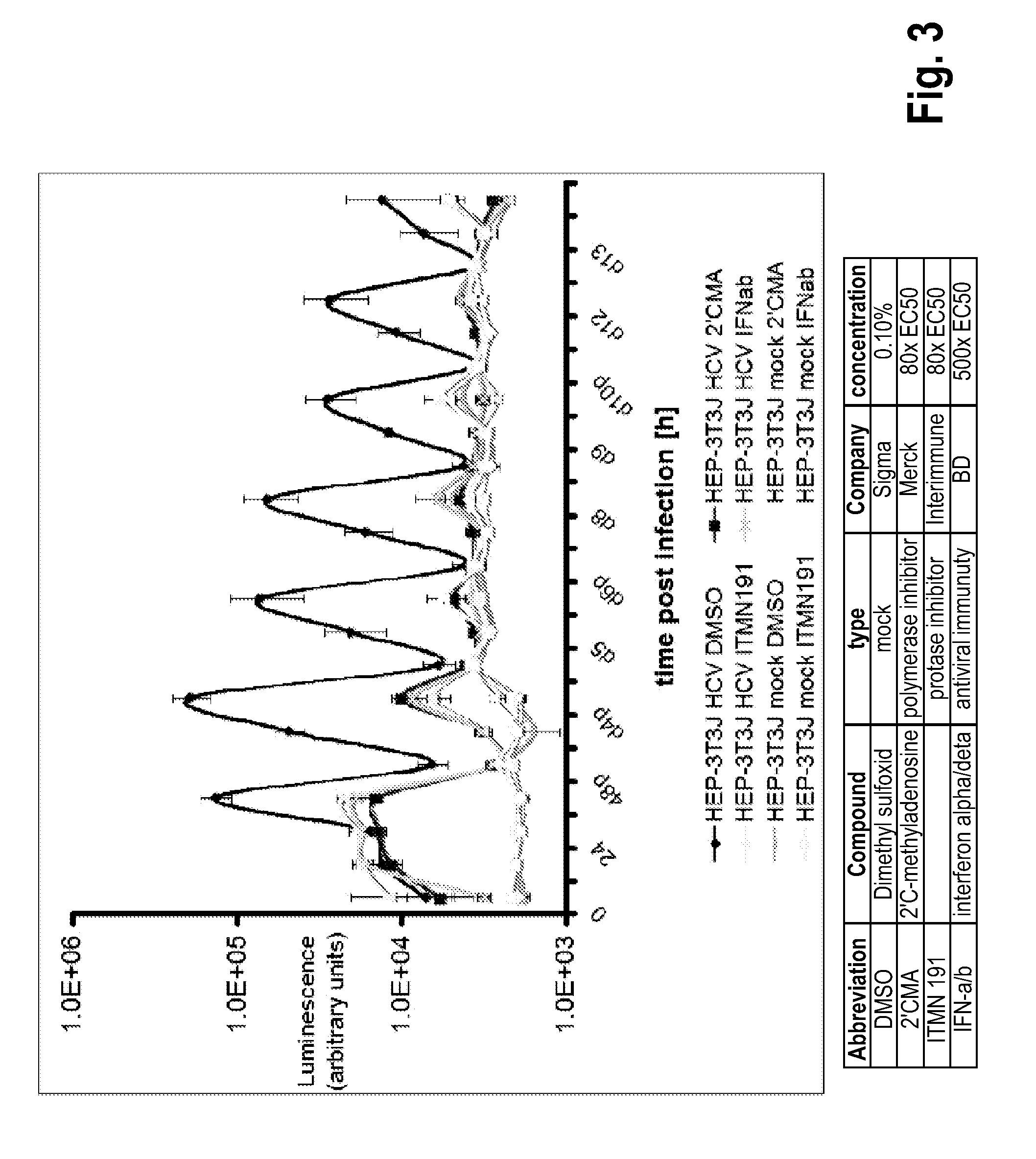Micropatterned co-culture systems as infectious disease analysis platforms
a co-culture system and infectious disease technology, applied in the field of micropatterned co-culture systems as infectious disease analysis platforms, can solve the problems of difficult realization of goals, severe side effects of ribavirin, and inability to cure many infected patients, and achieve the effect of high throughput experimentation and automated optical readou
- Summary
- Abstract
- Description
- Claims
- Application Information
AI Technical Summary
Benefits of technology
Problems solved by technology
Method used
Image
Examples
example 1
Disease Platform for HCV Drug Development
[0178]This Example presents the development and optimization of a disease platform for HCV drug development that couples micropatterned co-cultures of primary human hepatocytes and stromal cells in a multi-well format (FIG. 1) with highly sensitive viral reporter systems and optimized treatment protocols. The developed human liver platform can: a) Support entry of HCV-like particles via receptor-mediated processes (FIG. 2), and b) Produce and release infectious HCV particles into the culture supernatant for several weeks in vitro, and that such release can be blocked by treatment of cultures with small molecule inhibitors of viral proteins (FIG. 3). It was also found that infection of micropatterned co-cultures is dependent on the dose and time of exposure to the initial inoculum (FIG. 4), and magnitude of HCV infection in micropatterned co-cultures is 4-6 fold higher than in pure hepatocyte monolayers, the current gold standard in the field ...
example 2
A Fluorescent-Based Reporter for HCV Infection
[0180]A novel cell-based fluorescent reporter system has been developed to detect infection of unmodified HCV genomes. The example system described here uses an HCV-dependent fluorescence relocalization (HDFR) cassette that comprises a fluorescent protein (e.g. EGFP, mCherry or TagRFP), an SV40 nuclear localization sequence (NLS), and a C-terminal mitochondrial-targeting domain (IPS) derived from the interferon-beta promoter stimulator 1 protein, IPS-1. IPS-1 is a known cellular substrate for the HCV NS3-4A protease, and IPS-1 mutation C508Y has been shown to abolish cleavage. In HCV-infected cells the HDFR cassette is processed by the viral NS3-4A protease, resulting in translocation of the fluorescent protein from the mitochondria to the nucleus. Using a lentivirus based expression system to stably express the HDFR cassette, we have successfully established this system in the highly HCV permissive human hepatoma cell line, Huh-7.5 and ...
example 3
Live Cell Imaging of HCV Infection
[0185]Live cell imaging of HCV infection was demonstrated using the Huh7.5 cell line stably expressing a modified red fluorescent version of EGFP-IPS (Tag-RFP-nls-IPS) and mito-EGFP. TagRFP-nls-IPS encodes TagRFP (a bright red fluorescent protein), a SV40 nuclear localization sequence (nls), and the mitochondrial targeting sequence from the C-terminus of IPS-1. Mito-EGFP encodes the mitochondrial targeting sequence from subunit VIII of cytochrome-c oxidase. Localization of Mito-EGFP to the mitochondria, shown as green staining surrounding cell nuclei. Following HCVcc infection of the resultant cell line, relocalization of the TagRFP-nls-IPS from the mitochondria to the nucleus was visualized (red / violet staining of cell nuclei) as a result of cleavage by the HCV NS3 / 4A protease and subsequent transport to the nucleus via the nls. Mito-EGFP localization is unaltered by HCV infection and serves as a marker for the mitochondria. The stark visualization...
PUM
| Property | Measurement | Unit |
|---|---|---|
| concentrations | aaaaa | aaaaa |
| concentrations | aaaaa | aaaaa |
| distance | aaaaa | aaaaa |
Abstract
Description
Claims
Application Information
 Login to View More
Login to View More - R&D
- Intellectual Property
- Life Sciences
- Materials
- Tech Scout
- Unparalleled Data Quality
- Higher Quality Content
- 60% Fewer Hallucinations
Browse by: Latest US Patents, China's latest patents, Technical Efficacy Thesaurus, Application Domain, Technology Topic, Popular Technical Reports.
© 2025 PatSnap. All rights reserved.Legal|Privacy policy|Modern Slavery Act Transparency Statement|Sitemap|About US| Contact US: help@patsnap.com



